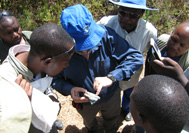Gold & Base Metal ProgrammesThere are two principal objectives to the metals exploration programme. The first is to evaluate the potential of the current Leland licences for commodities other than diamonds. The second is to identify additional exploration opportunities in Tanzania so that Leland’s exploration portfolio can be expanded prior to spinning it out into a separate, metals focussed, explorer. All mineral exploration programmes proceed in three phases: 1) target selection; 2) surface exploration and 3) subsurface exploration. The target selection process is completed mainly through the evaluation of available data on the target area, in this case the country of Tanzania. The data evaluation phase of the project started in July 2007. The initial phase of this review focused on gaining an understanding of the geology and mineralisation of Tanzania as a whole – this work is essentially complete. It became rapidly apparent that while a great deal of geological work had been carried out in Tanzania in recent times that no modern summary of the geology and in particular of the Precambrian aspects of the geology was available. A consultant with experience in regional data compilation was engaged to prepare a up-to-date summary of the geology of Tanzania which could be used as a basis for conceptual exploration planning. The first draft of this report was received in late January 2008. The literature search continued with an emphasis on gathering data on the types of mineral deposits in Tanzania. This review showed that the main commodities present, and of potential interest to Leland, were gold, nickel-copper with or without platinum group elements, uranium and to a lesser extent copper-gold.
Within the existing licences the principal target of interest is gold and to a lesser extent nickel-copper and uranium. The gold deposits in Tanzania are of a type known as “Orogenic” gold deposits which are controlled by large fault zones and often within or proximal to greenstone belts neither of which had been reported in the area of the Leland licences. The evaluation focused on determining whether large scale faults and/or unmapped greenstone belts were present in the licences through the reinterpretation and review of available regional scale aeromagnetic data. This work led to the identification of a number of large fault zone and potential greenstone belts within the licences indicating that further exploration for gold was warranted. Mapping and sampling are underway to quantify areas of potential mineralisation for drilling. |
   |



